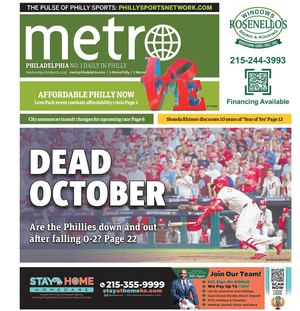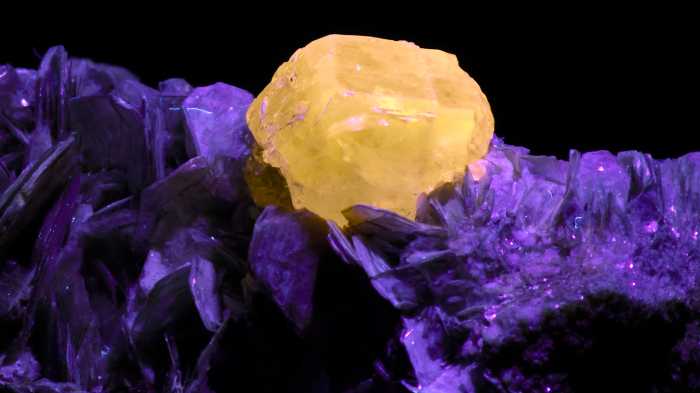Something changed last night as I huddled on the steps of my apartment building’s fire stairwell during the brunt of Hurricane Sandy. A loud boom rumbled through the air, followed by a flash of bright blue light.
“It can’t be lightning,” the girl standing next to me in the small cubbyhole said to her boyfriend. “Lightning is not that color. That was, like, cerulean.” The couple lives four doors down from the unit I’ve been renting for the past five months, but we had never met. “It’s the atmospheric conditions,” her boyfriend insisted.
Our heads snapped to attention as we heard four quick cracks followed by four more bursts of Technicolor light illuminating the sky blue, then green, then purple. Each seemed to be closer to us than the next. “Those are definitely transformers blowing,” the girl said “That is the sound of people losing power.”
She was right. We watched the lights in the parking lot across the street – long abandoned by its attendant – flicker and then die. It seemed a blackout was slowly spreading across our neighborhood and its path to us was imminent. So we started talking about what bars might be open.
I recently moved to a converted warehouse in Callowhill after living for eight years in a one-bedroom apartment in the Pennsport section of South Philadelphia. To say that I’ve been having trouble adjusting is an understatement. My old block was full of families and elderly residents who the first week I moved in lined up at my door to introduce themselves – and to get a read on me for neighborhood gossip mill fodder.
On the other hand, even though residents of my apartment building live physically closer together, the neighbors here – most of them young, many of them city transplants – are strangely isolated. There was no welcome party when I carried up my boxes on the first of May. No neighbors introduced themselves then or in the days following. I’ve gotten a lot of puzzled looks for asking strangers on the elevator how they’re doing. Maybe they don’t understand that in the greeting, at least in its Philly incarnation, the question is rhetorical.
I know what the storm prep would have been like in South Philadelphia. The few neighbors that had cars would have gone door to door asking if anyone needed any last-second staples from the supermarket. My boyfriend and I would have spent the two days before the hurricane hit carrying cases of water and bags of ice upstairs for the block’s older residents. In the breaks between the bands of high wind and pounding rain, we all would have periodically regrouped outside to survey who lost power, who had damage, who needed help.
Like everything else up here in our Callowhill apartment building, our storm preparations seemed to exist in a vacuum. We didn’t see anyone else carrying up cases of soda and cans of food from the parking lot to the elevator. Or buying fistfuls of mini flashlights at the corner gas station. Like most of our time living here, we didn’t see anyone else, period.
And then the storm hit, driving people outside if only to see the exploding transformers lighting up the sky like an apocalyptic urban aurora borealis. We spoke to more people that night than in our five months of residency, combined.
Though we never lost power – the creeping transformer explosion monster thankfully stopped at the parking lot across the street – we did end up at a bar that night. We ventured out around 11 p.m., when officials on the radio were telling everyone to stay inside. We were restless and hungry – I bought plenty of canned soup, tuna and peanut butter, cranked down the fridge temperature and filled the bathtub with water, but failed to make a contingency plan for what to do if the power did NOT go out. Cabin fever had set in.
About six blocks away was one of the rare places that had not shuttered its doors – its owners, we learned, lived a few blocks away. An orange tabby was stretched out in front of a small fireplace and a lively game of trivia was underway at the bar. The bartender brought us pulled pork sandwiches and pumpkin burgers and rattled off the sixteen beers on tap.
We encountered one of the girls playing trivia as we smoked a cigarette outside. She, too, had been driven to the bar by boredom, also lucky enough to dodge wind damage and power outages. “I need your help,” she said urgently. “What is a flammable byproduct of a llama?” I told her it had to be methane. We were in.
As the night wore on, wind-whipped people continued to pour in – many of them young, many of them city transplants like the residents of my building. The trivia got louder, then sloppier, then devolved into a tangle of inebriated conversations.
One guy showed storm shots he’d taken with a digital camera shielded from the elements in a shoebox with strategically-placed cutouts. Another detailed his hilarious quest for a generator in Center City the day before the hurricane hit.
No one there lost electricity. No one was flooded, injured or stranded. The neighborhood came together not to push someone’s car out of a ditch or to help wrestle a windblown windowpane under control, but to save one another from the boredom of being stuck inside for a night, protected but bone-chillingly isolated.
I have never felt more at home.


























